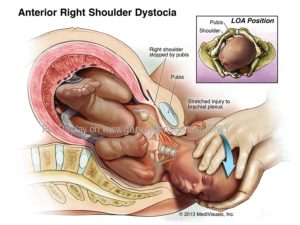injury case consultation
Available 24/7
Did you know that the very best position for a baby to come into the world is head first, face down? And how marvelous it is that the mother’s pelvic bones, on the inside, are shaped with ridges to direct the flow of the baby into that position, almost like baffles to direct the flow of water down a funnel?

The process of the baby’s journey down into the pelvis and then through it, well, that takes time. More so for some than others. And the process hurts the Mom, a lot! The medical providers may seek to hurry the process along, and to ease the mother’s pain. The mother’s labor can be regulated and speeded up by the use of a medicine called Pitocin. The mother’s pain can be eased by the use of narcotic pain medications. Unfortunately, these medical therapies may not be good for the baby. Be wary of these time-saving and pain-saving measures.
The problem is, the baby may not be ready to be pushed hurriedly down the birth canal and may not get into the best position for birth, and the baby may become sluggish and doped up because it gets the same narcotics that Mom gets, and becomes unable to do its part in finding its way into the world.
Birth injuries are often preventable. Routine tests and monitoring during delivery allow medical providers to anticipate and deal with problems.
Unfortunately, doctors do make mistakes and sometimes fail to act safely in cases of prolonged or difficult labor, with catastrophic results. A doctor may fail to detect and resolve shoulder dystocia or the umbilical cord wrapped around the child’s neck. Negative fetal vital signs might not be recognized, perhaps delaying treatment up to and including a required emergency c-section.
For instance, about 10 thousand children a year are born in the United States with cerebral palsy and about 6% of those cases are caused by oxygen deprivation during delivery. Other babies can suffer Erb’s palsy or stroke.
It is the duty of your obstetrician to exercise the degree of care and skill ordinarily exercised by a reasonably competent obstetrician in similar circumstances. That includes the duty to anticipate problems. If the obstetrician fails in this duty, there can be catastrophic results to the baby’s safety.
Sources: Centers for Disease Control and Prevention “Data and Statistics for Cerebral Palsy” https://www.cdc.gov/ncbddd/cp/data.html; and S. Politi et al., “Shoulder dystocia: an Evidence-Based approach,” J Prenat Med. 2010 Jul-Sep; 4(3): 35–42, available at https://www.ncbi.nlm.nih.gov/pmc/articles/PMC3279180/.